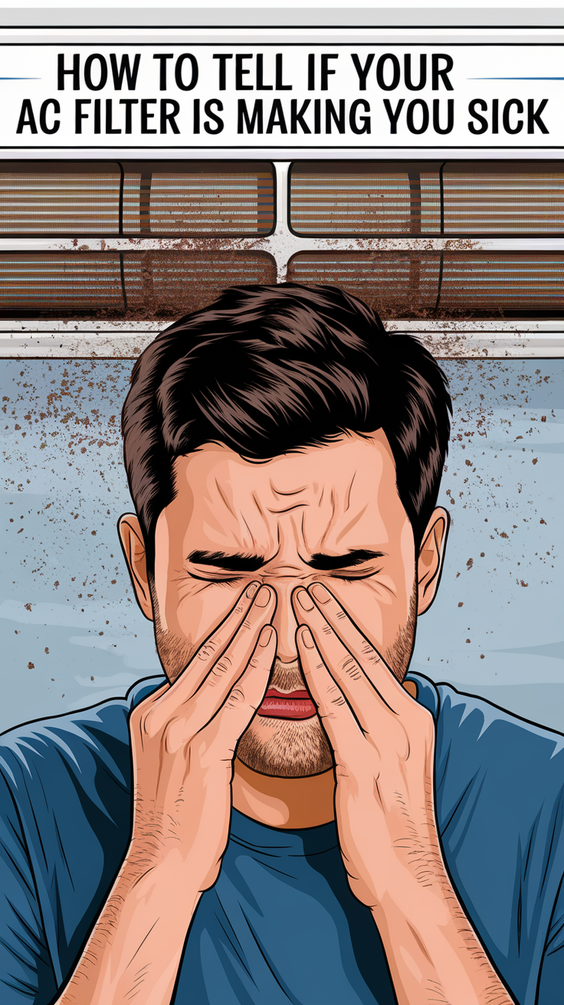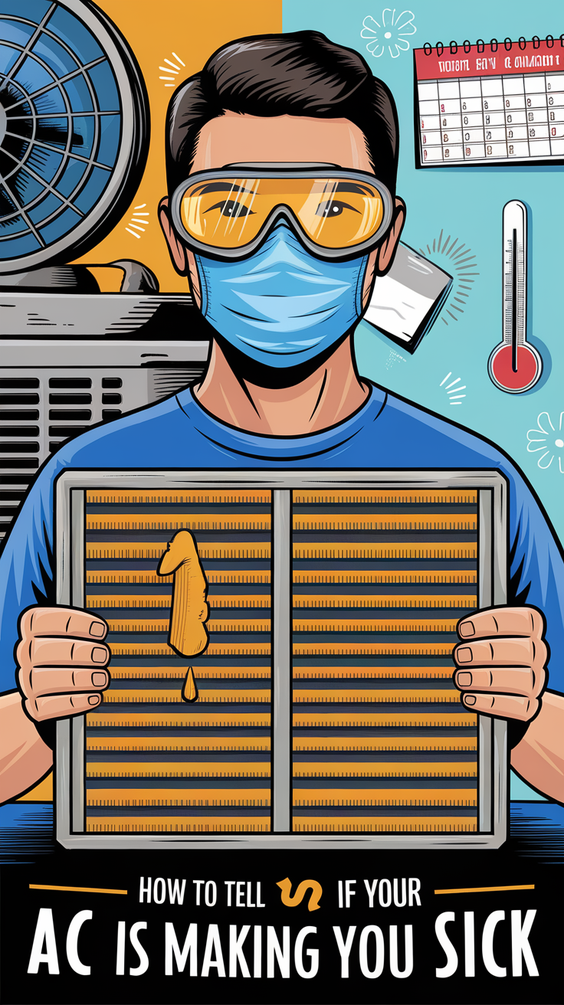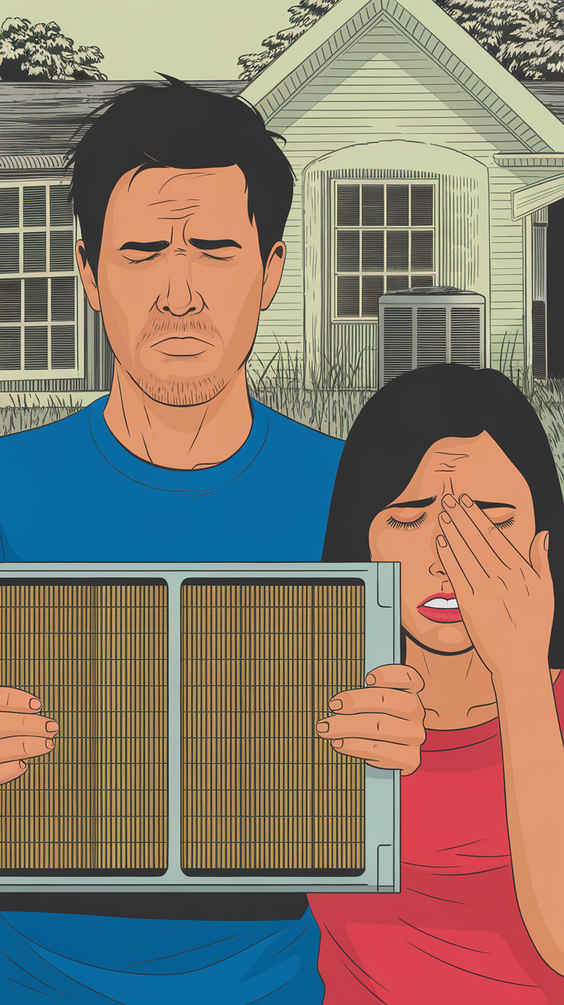Introduction
Have you been sneezing, coughing, or feeling unusually tired at home lately? What if the problem isn’t seasonal allergies or stress—but your air conditioner filter?
In 2025, indoor air quality has become a growing health concern across the U.S. The EPA reports that Americans dedicate 90% of their daily hours inside buildings where air pollutants reach levels 2 to 5 times greater than outside levels. The AC filter stands as one of the major concealed causes of illness. A dirty or outdated AC filter.
In this article, you’ll learn how to tell if your AC filter is making you sick, the signs to watch for, and how to protect your health. Whether you live in a hot, humid climate or rely on central air year-round, this guide will help you breathe easier—literally.
Why Your AC Filter Affects Your Health

What Does an AC Filter Do?
Your AC filter isn’t just there to catch dust—it’s the first line of defense against airborne irritants. It traps pet dander, pollen, mold spores, and even microscopic pollutants.
Over time, as the filter becomes clogged, it can no longer do its job effectively. Dirty filters let contaminants circulate through your HVAC system and back into your lungs.
How Dirty Filters Worsen Indoor Air Quality
A clogged or outdated AC filter becomes a breeding ground for bacteria and mold. As your system blows air through it, these harmful particles are spread throughout your home.
Think of it like trying to drink water through a straw filled with dirt—you’ll end up consuming more than you bargained for.
Common Symptoms Caused by a Dirty AC Filter
When indoor air is contaminated, your body reacts. Here are the most common health symptoms that may be linked to your AC filter:
Respiratory Issues and Allergies
-
Frequent sneezing, coughing, and runny nose
-
Worsening of asthma or bronchitis
-
Increased allergy symptoms, especially at home
Fatigue, Headaches, and Poor Sleep
Ever wake up feeling more tired than when you went to bed? The quality of interior air could be the root cause. Dirty filters can increase carbon dioxide and reduce oxygen flow in your home—leading to fatigue and brain fog.
Skin and Eye Irritation
-
Dry, itchy eyes
-
Skin flare-ups or irritation
-
More frequent eczema or psoriasis episodes
These symptoms often mimic seasonal allergies, making them tricky to diagnose. But if you feel worse indoors, it might be time to inspect that filter.
Warning Signs Your AC Filter Needs Replacing
You don’t have to be an HVAC technician to spot a problem. Here are visible and sensory cues that your filter needs attention:
-
Increased dust on furniture and surfaces, even after cleaning
-
Musty or stale odors when the AC is running
-
Uneven cooling in different rooms
-
Rising energy bills despite consistent usage
-
Noisy airflow or rattling sounds from vents
Quick Checklist
✅ Filter hasn’t been replaced in 3+ months
✅ You have pets or smoke indoors
✅ Home feels stuffy or causes discomfort
✅ Airflow seems weak or blocked
How Often Should You Replace Your AC Filter in 2025?
Recommended Timelines by Filter Type
| Filter Type | Ideal Replacement Frequency | Notes |
|---|---|---|
| Fiberglass (basic) | Every 30 days | Cheapest but least effective |
| Pleated (standard) | Every 60–90 days | Common for residential systems |
| HEPA filters | Every 6–12 months | Best for allergies, often reusable |
| Carbon-activated filters | Every 3–6 months | Great for odor and smoke control |
These are general rules, but your lifestyle matters too. Got pets? Smoke indoors? People who live in cities with high pollution levels need to consider different filter maintenance strategies. You may need to change filters more often.
What Happens If You Ignore a Dirty AC Filter?
Delaying filter changes may seem harmless—but it adds up fast:
-
Increased risk of illness: From headaches to sinus infections
-
Mold and bacteria growth: Filters can trap moisture, feeding mold colonies
-
HVAC system stress: Your system works harder, shortening its lifespan
-
Poor indoor air quality (IAQ): Pollutants continuously cycle through your space
In extreme cases, dirty filters can contribute to Sick Building Syndrome, a condition where prolonged exposure to poor IAQ leads to chronic fatigue, irritability, and even nausea.
How to Check and Change Your AC Filter Safely
Step-by-Step Instructions
-
Turn off your HVAC system. This prevents dust from blowing around.
-
Locate your filter. Most are found behind return vents or in the furnace/air handler.
-
Remove and inspect it. Hold it up to the light. If you can’t see light passing through, it’s clogged.
-
Replace with a matching filter. Check the size and MERV rating.
-
Install properly. Arrows should point in the direction of airflow.
-
Turn system back on and monitor performance.
💡 Pro Tip: Set calendar reminders every 60–90 days to check your filter, especially during high-use seasons.
Choosing the Right AC Filter for Better Health
Not all filters are created equal. Here’s how to choose what works for your household.
Understanding MERV Ratings
MERV stands for Minimum Efficiency Reporting Value. It ranges from 1 to 16:
-
1–4: Basic protection (pollen, dust)
-
5–8: Standard for most homes
-
9–12: Better filtration for allergens
-
13–16: Hospital-level filtration (traps bacteria, smoke, viruses)
For most homes, MERV 8–11 strikes the right balance between performance and airflow.
When to Use HEPA or Carbon Filters
Choose HEPA filters if:
-
You or a family member has asthma
-
You have pets
-
You live in a high-smog area
Use activated carbon filters to control:
-
Cigarette smoke
-
Kitchen odors
-
Volatile Organic Compounds (VOCs) from paints or cleaners
Tips for Maintaining Air Quality Beyond the AC Filter
Clean air isn’t just about filters. Try these additions:
-
Vacuum with a HEPA-filtered vacuum
-
Dust regularly using microfiber cloths
-
Use a dehumidifier to prevent mold growth
-
Open windows on low-pollen days to ventilate
-
Add air-purifying plants like snake plant or peace lily
🌿 Did you know? NASA studies show some houseplants can reduce indoor toxins by up to 87%.
What Experts and Recent Studies Say in 2025
In a recent 2025 report by the American Lung Association, over 70% of households had filters with poor airflow efficiency. Many homeowners reported noticeable improvements in allergy symptoms just one week after replacing filters.
HVAC professionals now recommend quarterly inspections—even if the filter isn’t fully clogged—to ensure your system runs at peak health and performance.
🧠 “Changing your air filter is one of the easiest ways to improve air quality and reduce health risks indoors,” says Dr. Lena Ramirez, indoor air quality expert.
Conclusion – Don’t Let Your AC Filter Make You Sick
To recap:
-
A dirty AC filter can cause respiratory symptoms, fatigue, and skin irritation.
-
Simple warning signs include dust buildup, odd smells, and increased energy costs.
-
Replace your filter every 1 to 3 months, depending on your lifestyle and filter type.
-
Choosing the right MERV rating can drastically improve air quality.
-
Clean air requires a holistic approach: ventilation, cleanliness, and smart filter choices.
Now over to you:
When was the last time you checked your AC filter? Could it be the hidden cause of your discomfort?
👇 Share your experience in the comments—and breathe easier knowing you’re not alone.


